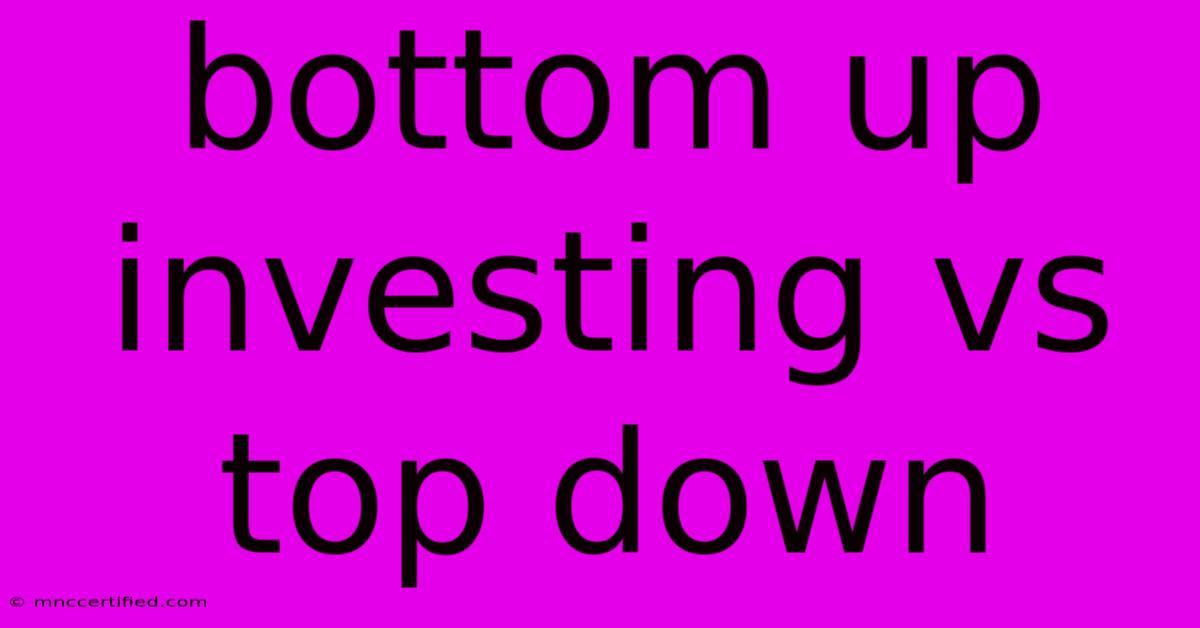Bottom Up Investing Vs Top Down

Table of Contents
Bottom-Up Investing vs. Top-Down Investing: Which Strategy Suits You?
Choosing an investment strategy is a crucial decision that can significantly impact your portfolio's performance. Two prominent approaches are bottom-up investing and top-down investing. Understanding their differences is key to selecting the method best aligned with your investment goals, risk tolerance, and time horizon. This article will delve into the nuances of each, highlighting their advantages and disadvantages to help you make an informed choice.
Top-Down Investing: A Macro Perspective
Top-down investing begins with a macroeconomic analysis. Investors start by examining broad economic trends, such as global growth, interest rates, inflation, and geopolitical events. They then narrow their focus to specific sectors or industries that are expected to perform well within this macroeconomic environment. Finally, they select individual companies within those promising sectors.
Advantages of Top-Down Investing:
- Macroeconomic Awareness: This approach emphasizes understanding the big picture, allowing investors to identify opportunities and mitigate risks stemming from broader economic shifts.
- Strategic Allocation: It facilitates a well-diversified portfolio by focusing on sectors predicted to outperform, potentially leading to higher returns.
- Reduced Emotional Decisions: By focusing on the overall economic landscape, investors can make more rational, less emotionally driven investment choices.
Disadvantages of Top-Down Investing:
- Over-Reliance on Macroeconomic Forecasts: Economic predictions can be inaccurate, potentially leading to poor investment decisions.
- Missed Opportunities: Focusing on macro trends might cause investors to overlook promising companies in underperforming sectors.
- Less Company-Specific Insight: A top-down approach might lack the detailed fundamental analysis necessary to identify undervalued gems.
Bottom-Up Investing: Focusing on Fundamentals
Bottom-up investing adopts a completely different approach. It prioritizes fundamental analysis of individual companies. Investors meticulously research companies, examining their financial statements, management teams, competitive advantages, and future growth potential. The macroeconomic environment plays a secondary role.
Advantages of Bottom-Up Investing:
- Detailed Company Analysis: This method allows for in-depth research, potentially uncovering undervalued or underappreciated companies.
- Identification of Growth Opportunities: By focusing on individual companies, investors can identify high-growth potential that might be missed by a broader macroeconomic analysis.
- Reduced Dependence on Market Sentiment: Bottom-up investors are less susceptible to market fluctuations and investor sentiment, focusing instead on intrinsic value.
Disadvantages of Bottom-Up Investing:
- Time-Consuming: Thorough fundamental analysis requires significant time and effort.
- Requires Expertise: A strong understanding of financial statements and valuation techniques is crucial.
- Higher Transaction Costs: Frequent trading based on individual stock selection can lead to increased brokerage fees.
Combining Top-Down and Bottom-Up Strategies: A Hybrid Approach
Many successful investors employ a hybrid approach, combining elements of both top-down and bottom-up strategies. This allows them to benefit from the macroeconomic awareness of the top-down method while still conducting thorough fundamental analysis of individual companies. For example, an investor might use a top-down approach to identify promising sectors and then use a bottom-up approach to select specific companies within those sectors.
Which Strategy is Right for You?
The best investment strategy depends on your individual circumstances and preferences.
-
Top-down investing might be suitable for investors who:
- Prefer a less hands-on approach.
- Have a higher risk tolerance.
- Are comfortable relying on macroeconomic forecasts.
-
Bottom-up investing might be suitable for investors who:
- Enjoy in-depth research and analysis.
- Have more time to dedicate to investing.
- Prefer a more active investment strategy.
Ultimately, the key to success in investing lies in understanding your own strengths, weaknesses, and risk tolerance. Consider your investment goals, time horizon, and resources before selecting a strategy. And remember, diversification is always crucial, regardless of the approach you choose. Consulting with a financial advisor can also provide valuable guidance in determining the best strategy for your unique circumstances.

Thank you for visiting our website wich cover about Bottom Up Investing Vs Top Down. We hope the information provided has been useful to you. Feel free to contact us if you have any questions or need further assistance. See you next time and dont miss to bookmark.
Featured Posts
-
Tenbury Wells Floods Storm Bert Photo Gallery
Nov 26, 2024
-
Insurance Direction To Pay Form
Nov 26, 2024
-
Liverpool Vs Real Madrid Watch Ucl
Nov 26, 2024
-
Homeowners Insurance Abilene Tx
Nov 26, 2024
-
Lopetegui Could Recall Areola Vs Newcastle
Nov 26, 2024